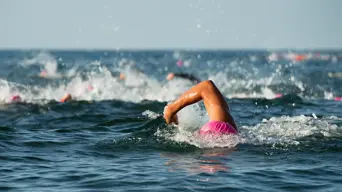2 Iron Man athletes die, sparking questions over safety protocols
Kabous Le Roux
20 November 2025 | 11:03The triathlon community was rocked by tragedy this weekend when two athletes, aged 29 and 58, died during the swimming leg of the Ironman triathlon in Mossel Bay.

Open water swimming (123rf.com)
Both incidents occurred just 15 minutes apart, with safety personnel extracting one swimmer at 400 meters and another at 1,000 meters. Despite being rushed to the hospital, both athletes were later declared dead.
As the news spreads, questions about safety protocols and emergency response times have emerged, with very little information forthcoming from event organisers. Daily Maverick journalist Younger Sabembe, who covered the story, shared insights into this developing situation.
"It's a slippery slope, of course, because we know that these events are quite demanding physically, even the preparation as well," Sabembe explains. "Never mind the day itself, but what about the preparation in the lead up to that? What kind of preparation was a person doing? There are a lot of factors that we have to look at."
What makes these deaths particularly concerning is that both occurred during the swimming portion of the event, which research has shown to be the most dangerous leg of triathlons. The conditions on race day were reportedly very rough, contributing to the difficulties faced by participants. At least one other athlete had to be pulled from the water by rescue teams, suggesting the emergency responders had their hands full managing multiple incidents.
While professional athletes make up a portion of participants, many entrants are enthusiasts looking to test their physical limits. Questions have been raised about the screening process for participants and whether enough is being done to ensure athlete safety. Currently, medical certificates are required, but some wonder if more stringent measures should be implemented.
"I think organisers need to step up and be responsible or take more accountability," Sabembe notes, pointing out that this isn't the first such incident. "Especially when you know there's a precedence and history says that even as recently as April this year, someone else died during the swimming leg of the triathlon."
The lack of response from Ironman organisers has only intensified concerns. Despite multiple inquiries about safety protocols, response times, and potential changes to future events, no official statements have addressed these critical questions.
As one WhatsApp commenter astutely observed, "Training solo in a swimming pool and competing in the ocean with hundreds of others is very different,”highlighting the unique challenges that mass-participation open water swimming presents.
The triathlon community now waits for answers as families mourn their loved ones.
Click below to hear Sabembe provide additional context to this unfolding story:
Get the whole picture 💡
Take a look at the topic timeline for all related articles.















